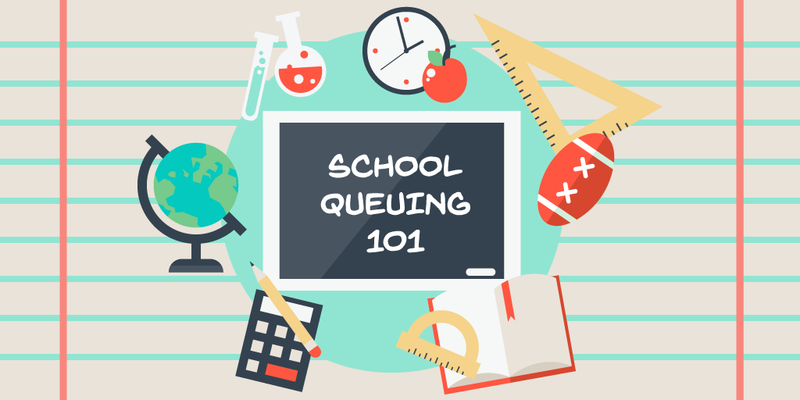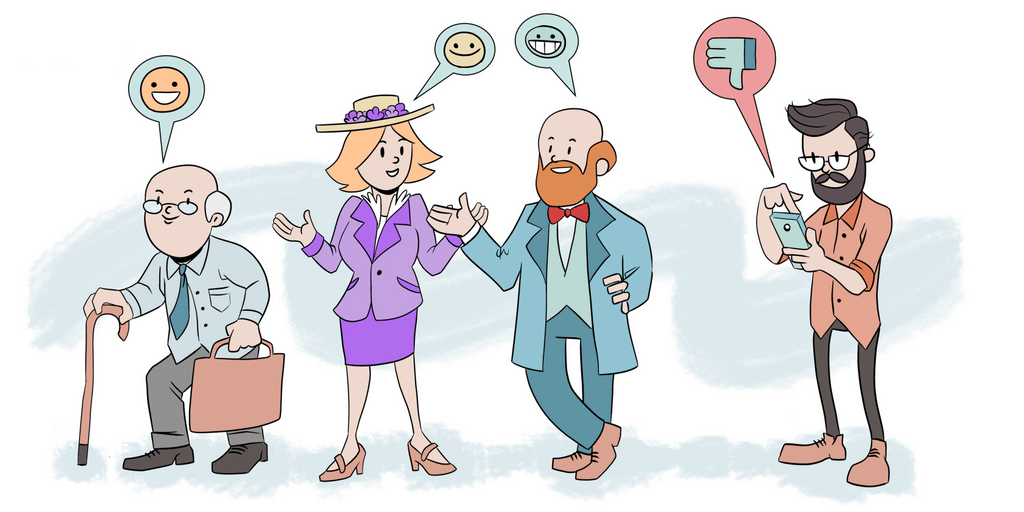When we're talking about queues, you probably imagine a long line of people in a grocery store, hospital or government office. But waiting lines happen everywhere, and everyone can become their victim.
Namely, students.
Despite sometimes being as disastrous as in retail, queuing in schools is largely ignored. The usual reply to a phrase "school queue management" is, at best, a polite shrug.
So what's the situation with queues in educational facilities and can they benefit from proper queue management?
Let’s dive right into it.
Why Enrollment in Schools Takes So Long
The first contact with queuing in schools happens as we are trying to enroll.
You may think enrollment, as a once-a-year event, poses no great risks. At its worst, it can still be suffered through, right?
But the effects of long waiting lines can be extremely disruptive.
Case in point: Johannesburg, South Africa, where parents had to endure a 1-km-long queue so they could register their children.
Even though school gates only opened at 6:30, parents began queuing from 4:00, and by 6:00 all the parking spots were taken.
The situation grew so desperate that some parents decided to pay other people to stand in their place. One such employed man said he got paid 250 rands (about 19 USD) and two meals for queuing.
And the worst thing about these queuing incidents? They’re so widespread that people started taking them for granted.
We've already talked about how retail benefits from queue management and how hospitals need to implement a queuing system.
But does the same apply to schools suffering from mismanaged queues?
Queue Management for Enrollment: The Process and Benefits

While this queuing situation in schools can be partially solved by a more efficient waiting area layout, the core problem lies in queue management itself.
The solution, therefore, is to invest in a queue management system for schools.
Queue management system is not just a tool to help students spend less time waiting, it is an integral part of communication between the administration and students.
With high volumes of students coming in, it is as important to predict as it is to manage. A queuing solution lets you do both.
When managing students — especially during enrollment — you have to take into account the psychology of queuing.
As far as students see, waiting is disruptive and unnecessary. By failing to minimize or explain waiting times, you risk exacerbating the problem.
But what does queue management system do that improves school queuing?
For one, the ability to see, at a glance, the number of students currently in queues as well as their waiting times greatly improves the control over the entire process.
The main requirements of a queue management system is to streamline heavy student flow and help them find the right representative or authority.
However, since schools are mostly dealing with young people, they need to take into account another aspect of student communication.
Students prefer to get engaged with their mobiles.
As a form of communication, text messaging outranks phone calls among Millennials. It is also less preferable to direct engaging, as young people are more likely to skip small talk and get straight to the matter.
That’s why the inclusion of mobile queuing is so important. By taking advantage of this form of communication, schools can further improve queuing, minimizing the toll of enrollment queues.
Modern data-based queuing systems take these nuances into account by encouraging service feedback and analytics.
By helping you measure the quality of your services, school queue management system can pinpoint the lacking area at the most critical time — including the enrollment period.
Long Lunch Queues and Their Effect on Students
Long queues greet us as soon as we try to enroll in a school, but they don’t let up for the entirety of our school life. The biggest offender by far is lunch queuing in schools.
Long waiting time by itself is a bad experience, but when you couple it with a limited available time to have lunch, that is a recipe for disaster.
A secondary school in London found this out the hard way, as its pupils were shunning food in a school canteen. They even preferred buying their own food to having healthy meals prepared from a recipe of chef Jamie Oliver.
Sarah Sinclair, lead researcher of the Nutrition Policy Unit of London Metropolitan University, identified the issue as long waiting time and poor waiting area layout:
“Our discussion groups with pupils and parents showed the main reason was that the canteen is too small to accommodate all the pupils it needs to, and long queues mean that pupils have no time left in their lunch break for any other activity such as sport or play.”
The result? Children were buying cheap junk food that didn’t meet nutritional requirements and posed long-term health risks to pupils.
All because of disorganized, poorly managed queues.
This queuing problem is not limited to smaller schools, either. Even expensive education facilities fall prey to long waiting times.
In Neath, South Wales, pupils of a £40m Baglan Bay high school have waited throughout the entire lunch break and had to go back to class on an empty stomach.
And the culprit? Unsurprisingly, it was again long waiting time.
Thankfully, the school recognized the problem:
“We are also improving our queueing systems, we are opening up the bigger hall to make more space, staggering lunch to ease congestion and improving our information to pupils so that they are better informed about what is on offer in each canteen.”
That should at least take care of long waiting times. But surely, there must be some radical way to minimize lunch queuing in schools?
How to Make Lunch Queues More Tolerable

Lunch queues in schools are a huge problem, but it’s not unsolvable. Especially if you take a cue from primary schools in Bath and North East Somerset, who decided to think outside the box.
These primary schools managed to completely turn around their lunch experiences, transforming them into fun social events.
Here’s a quick recap of their best practices on school lunch experience.
First of all, they recognized that the normal way to service takes too long. That’s why cutlery is already placed on tables when children come in during lunch, and there are self-service salad bars in the lunch area.
The schools did not stop there. Since some children take time to choose their meal, while others may be too shy to speak at all, something had to be done about that as well.
The answer came in the form of colorful bands that kids can put on to help quickly identify which food to serve them.
Carolyn Banfield, headteacher at St John’s C of E primary school, explains the system:
“The children are coming to school in the morning, and they know what the menu is. They select the appropriate band: green for vegetarian, red for meat dishes. And then we can guarantee that they will have what they’ve chosen to have.”
Secondly, to better manage the influx of students, there are more sitting and service points. The school lunch area can accommodate not only every single student but also teachers who join the children.
Additionally, rotating serve order helps minimize situations where certain classes or students always get served last.
Lastly and more importantly, school canteens provide what they call a “family service approach”. To help their kitchen staff, older students volunteer as “Bistro Buddies” — their version of happy helpers.
These Bistro Buddies cut and collect food for younger students, which makes for a faster — and more importantly, more sociable — atmosphere.
And, as a bonus, it teaches them responsibility in a fun, relatable way.
The takeaway? Don’t be afraid to shake things up and experiment with the status quo. When people have something to do other than wait, queues don't look as bad as they used to be.
Waiting Lines in the Admission Office
Enrollment and lunch queues are prominent examples of how bad the school queuing situation is. Unfortunately, we still haven’t fully explored all the long queues students have to suffer through in schools.
No matter how streamlined and efficient you think your school process is, students will still find a way to have questions about it.
They might need information about exams and schedules, but there also might be questions about events, payments, food menu, or guest speakers — to name a few.
All these student enquiries are usually answered in admission offices. With high volume of students and limited available time — either between subjects or after school — this means a high chance of long wait time.
Students, who are busy as it is with their academic studies, don’t want to spend hours upon hours waiting for an answer to their question.
Just like customers in retail or patients in a hospital, students want a fast, seamless service that requires as little input from them as possible.
Besides, their life is already filled with long queues and wait times. Waiting in the admission office after having waited in a school library is simply too much.
Can a queue management system actually help with this situation?
Let’s take a closer look at a college that successfully uses the Qminder management system for controlling its queues.
Using Queuing System in Schools: A Case Study of La Cité College

La Cité is a French-language community college based in Ontario, Canada.
With about 5000 full-time students, La Cité always has someone in need of help or answers. This is especially true for the beginning of the semester, but help is needed throughout the entire school year.
The questions that students ask can vary from which classes to take and how to switch them, to financial matters.
Before they found out about Qminder, La Cité was using an outdated ticket-based queuing solution. Not only there were technical and cost-related issues, the fact that the system used paper was a problem in itself.
“We are eco-friendly, and didn’t want to use so much paper”
Catherine Sainte Marie, a recruiting manager at La Cité.
But the biggest issue was that it felt really impersonal. Using numbers instead of first names meant there was extra time wasted for every person not immediately recognizing it’s their turn.
It’s only when La Cité started using Qminder for their admissions office that they recognized the power of a name-based approach.
Firstly, it helped students standing in queues know right away if they’re being called. After all, you can forget a random number but not your name.
Secondly, it helped with building a more cozy, friendly environment where everyone knew each other.
How La Cité’s Waiting Area is Organized

The college has 10 full-time employees, with several part-time employees (which includes volunteering students) during busy times.
Creating additional accounts with an access to the system is easy, and La Cité takes full advantage of it.
For better visibility, there are three TVs installed — one in the waiting area, one in the front room of the admission office, and the third one inside for internal use.
The service lines change based on the traffic and trending needs. Sometimes people come in to ask the same questions, and having one person serving these students makes for a more efficient process.
The queuing process is smooth and stable, with little changes throughout the school year. The exception is busy periods — such as the end of semester — when there are multiple iPads at use.
The Benefits of a Queuing Solution at School
As La Cité managers say, setting a queue management system up was easy and did not require much help from the IT department. For the most part, clerks can manage the system themselves.
The ability to add instructions in different languages is an extra advantage to the Qminder system — especially for colleges like La Cité.
Since La Cité offers educational programs to students from foreign countries, intuitive use was an important point to cover as well.
Even students who had limited familiarity with technology were able to master it in short time.
Since Qminder uses iPads and phones as its core devices, students had no problems picking up this new technology.
Last but not least, there is a possibility to use a waiting line management system to fetch valuable data. For example, the average service time per line and clerk.
This way, managers can know when they need to train their staff or recognize someone’s efficient work.
Historical data allows to compare present data to that of last year’s. Staying ahead of the curve is as important in schools as it is in retail, and La Cité pulls it off magnificently.
La Cité is an award-winning college that was recognized, among many other things, for its exceptional overall quality of services.
Want to achieve the same results? Get a free 14-day access to Qminder and start experimenting!






